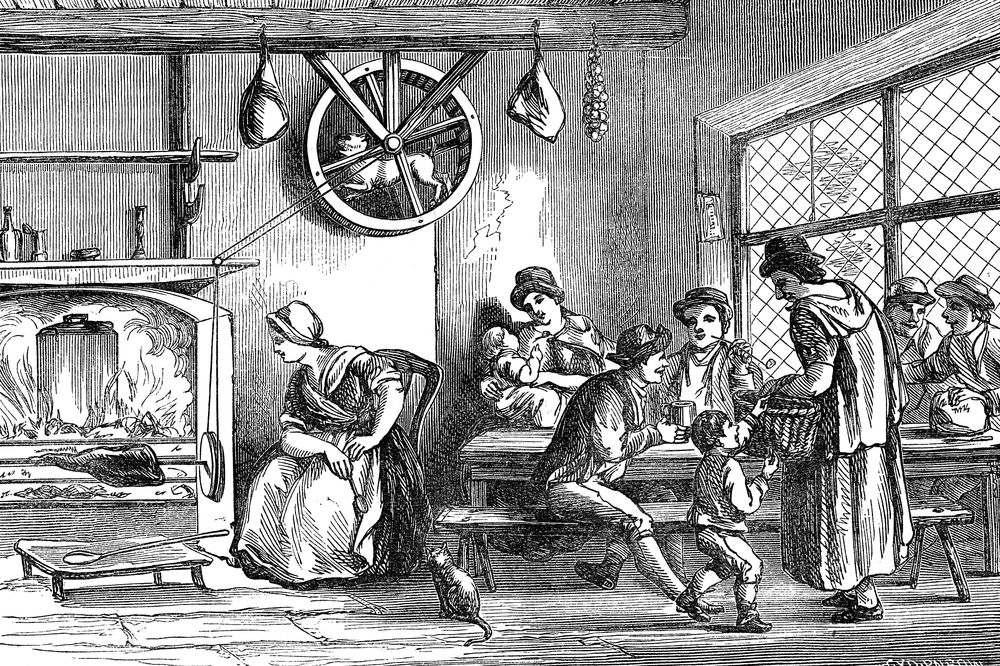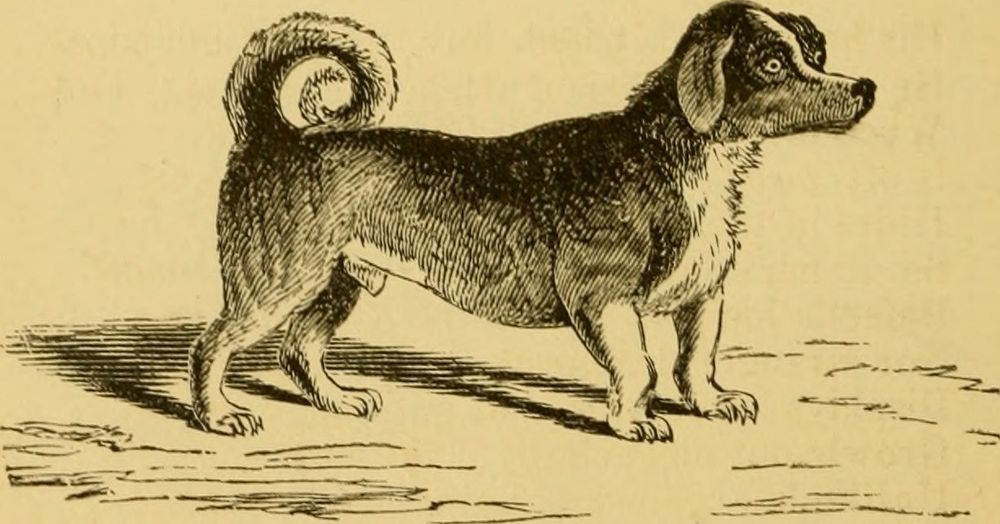
Observe the scene above depicting the inside of an inn at Newcastle, Wales, in the late 19th century. Men and women are sitting around the tables gossiping over drinks and smoke, waiting for the meat to get done. A woman is sitting by the fire tending the rotisserie, but the actual work is being done by a small dog furiously running inside a small hamster wheel hanging from the ceiling. He is the turnspit dog—a short-legged, long-bodied dog breed with a heavy head and drooping ears. Famed zoologist Carl Linnaeus named them Canis vertigus, Latin for "dizzy dog," because the dogs were turning all the time.
The turnspit dog’s duty was to keep the spit rotating. It was a tiresome job, once performed by small, luckless boys, in the kitchens of the wealthy and those of the royals. The heat from the open hearth was unbearable and it took hours of cranking for the meat to be evenly roasted from all sides. Sometime in the 16th and 17th centuries, households across Britain began to replace young boys with animals—preferably dogs, but records suggest that some cooks preferred geese because of their greater stamina and lesser trouble.
To turn the spit, a devilish device was created. It consisted of a hollow wheel, much like a hamster’s wheel, whose rotating axle was connected to the spit with a chain or strings. As the dog ran, like a hamster in a cage, the spit turned. The wheel was usually kept away from the fire so as not to overheat the dog. That was as much compassion the poor dog received. He was just another kitchen tool, a piece of machinery, rather than a living being. The scullion kicked him, the cook flogged him. Sometimes a glowing coal was thrown into the wheel to make the dog run faster.

The turnspit dog often worked in pairs to relieve each other at regular intervals.
“The dogs were quite able to appreciate the lapse of time,” wrote John George Wood, in The Illustrated Natural History published in 1853. “If not relieved from their toils at the proper hour, would leap out of the wheel without orders, and force their companions to take their place, and complete their portion of the daily toil.”
Unequal share of workload was often the cause of fights and bickering among the dogs.
In A book about the table, author John Cordy Jeaffreson wrote:
Abused by men of all degrees, and scorned by every other “dog of the house”, a pair of turnspits were continually snarling at and fighting each other. Each accused the other of shirking his fair share of their common work, and devouring more that his fair share of their common ration; and in their mutual rage they would sometimes fight to the death. Buffon tells the story of a turnspit dog that, on escaping from the wheel in the Duc de Lianfort’s kitchen in Paris, ran in upon his fellow turnspit and killed him, because the latter had, by sulking, compelled him to perform an additional spell of work. A similar incident occurred at the Jesuit’s College of La Flèche, where a turnspit dog, infuriated by being compelled to work in the wheel when it was his turn to be resting, had no sooner escaped from the cage of torture than he hunted out his dishonest comrade, and, after a brief conflict with him, took his life.
Turnspits dog were employed not only in kitchens. They also drove fruit presses, butter churns, water pumps and grain mills. On Sundays, families took them to church, because these dogs made good feet warmers. One story goes that during service at a church in Bath, the Bishop of Gloucester gave a sermon and uttered the line “It was then that Ezekiel saw the wheel...”. At the mention of the word “wheel” several turnspit dogs, who had been brought to church as foot warmers, ran for the door.
The turnspit dog was a distinct breed, specially bred by British dog breeders for the job. They had to be small enough to fit inside the wheel, but they also had to be strong and energetic, and intelligent enough to be trained. Charles Darwin often cited the turnspit dog as an example of selective breeding and genetic engineering. He once wrote, “Look at the spit dog. That’s an example of how people can breed animals to suit a specific need.”

"Whiskey," a taxidermied turnspit dog on display at the Abergavenny Museum in Wales. Photo: The Kitchen Sisters
In 1750, turnspits were everywhere in Great Britain. But by the late 19th century, turnspits had became scarce replaced by mechanical spit-turning machines, called clock jacks, driven by steam, springs or dead weight. Eventually, they entirely replaced dogs and the breed died out. Others believe that this dog breed simply morphed into one of the breeds we recognize today, such as the Welsh Corgi or the Glen of Imaal terrier.
The last surviving specimen of a taxidermied turnspit dog is at a small museum on the grounds of an ancient Norman castle in Abergavenny, Wales.
References:
# NPR, https://www.npr.org/sections/thesalt/2014/05/13/311127237/turnspit-dogs-the-rise-and-fall-of-the-vernepator-cur
# John Cordy Jeaffreson, A book about the table, https://archive.org/details/bookabouttable02jeaf/page/n5/mode/2up



Comments
Post a Comment